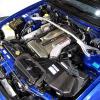Nitrogen Filled Tyres
Announcements
-
Similar Content
-
Latest Posts
-
Update: Tunehouse looked into the problem and identified a wiring issue between the camera unit and the connector. They managed to get it working , but did warn me at some point it will stop working again. From their perspective it is unserviceable and will need replacement. They did some research and found that the new replacement camera would be Approx $1400 supply only (their fitting cost would be $190) . They did provide the part number (28442-JL05B) and a quick google of the part number shows that these are rather expensive brand new (seemingly no longer in manufacture) for the places that still have them in stock, with the used option potentially presenting the same issue down the track at some unknown point. They are happy for me to supply the part so that they can fit it. Decisions, decisions... I can definitely recommend Tunehouse (thankyou Vee37!). Cost for the diagnosis was as quoted ($190) , car was ready on time and communication was top notch. Their workshop is super clean and modern, and there was plenty of car candy parked out the front on the day I went. Would definitely go back.
-
to fix the voltage drop issue I swapped out the old 150amp alternator which turns out is a brand known for having issues and replaced it with the black 180amp alternator beside it
-
For anyone interested, the Way Back Machine has that Japanese website archived with pictures, etc: https://web.archive.org/web/20051023225805fw_/http://www.a31cefiro.com/air_con.htm "Simply swapping the wiring of the harness will not allow it to function properly. For the outdoor air sensor and sunlight sensor, disconnect the wiring connected to CN1-11 of the air conditioning harness from the harness and connect the sensor side wiring to earth. For the indoor air sensor, disconnect the wiring connected to CN2-3 of the air conditioning harness from the harness and connect the sensor side wiring to earth. The connector PIN numbers listed here are the genuine A31 PIN numbers. To avoid incorrect wiring, check with a tester before wiring. Also, disconnect the wiring in a location close to the sensor. The disconnected harness side wiring will not be used, so be sure to insulate it." Wish someone sold a conversion harness to just plug-and-play a Kouki 180sx digital climate control into C33/A31. I'm decent with wiring but feeling kinda lazy about taking this on. Edit: Did some more digging and found a helpful Minkara blog post about the conversion as well: https://minkara.carview.co.jp/userid/1831116/car/1360568/2284209/note.aspx "After installation is complete or the battery is replaced, you need to go into self-diagnosis mode and set the internal air recirculation. The way to do it is to "hold OFF with the key on for more than 5 seconds, set the number to 5, then press 卍→C." ↑↑↑It probably won't make sense unless you actually try it (・∀・)." Lol wtf
-
Maybe SAUNSW could see howany members would do a motorkhana day if Schofield's is still available for a reasonable price...
-
Skip the concrete, we just need to smooth a field. Mark knows how to drive a grader Duncan I reckon 100x100 flat area for skid pan style, and then some sort tracks for rally... Duncan's already got a rally car on the premises to...
-






Recommended Posts
Create an account or sign in to comment
You need to be a member in order to leave a comment
Create an account
Sign up for a new account in our community. It's easy!
Register a new accountSign in
Already have an account? Sign in here.
Sign In Now